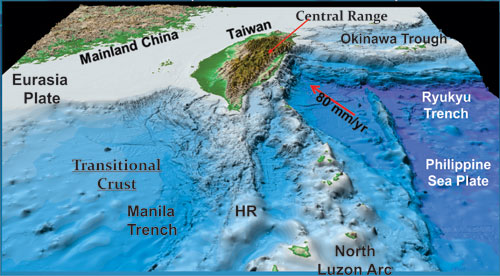The transition from subduction to arc-continent collision:
How it works in Taiwan
By:
Kirk McIntosh (UTIG),
Harm van Avendonk, Luc Lavier, Ryan Lester, Dan Eakin,
Francis Wu, Char-Shine Liu, Chao-Shing Lee, and Hao Kuo-Chen
| When: | Friday, September 13, 2013, 10:30 a.m. to 11:30 a.m. Join us for coffee beginning at 10:00 a.m. |
| Where: | Seminar Conference Room, 10100 Burnet Road, Bldg 196-ROC, Austin, Texas 78758 |
| Host: | Nick Hayman, UTIG |
Click for a Live Broadcast.

Abstract
Island arc-continent collision occurs when an ocean basin is completely subducted and the over-riding island arc impacts the continental margin. This process is thought to be an important mechanism for adding material to cratonic blocks and developing continental crust.
Although this process is important through Earth history, modern analogs are limited to collisions at the northern margin of the Australian plate (Banda Arc and the Bismarck Arc), north African margin with Mediterranean arcs, and in Taiwan.
The TAIGER (TAiwan Integrated GEodynamics Research) project was designed and executed to better understand and document the collision of the N. Luzon arc with the Eurasian continental margin. TAIGER included MT profiling, a large temporary array of broadband passive seismographs, onland recording of explosive sources, an extensive onshore/offshore and marine wide-angle seismic program, and a regional, marine seismic reflection program. The Taiwan area is particularly advantageous to study arc-continent collision because as an ongoing and migrating collision we can examine different stages of collision-from pre-collision states to mature collision.
In this presentation I will focus on the pre-collision structure of the Eurasian passive margin and then trace the transition from subduction to collision along the Manila trench/N. Luzon arc to Taiwan. One of the key findings of this project is that the Eurasian continental margin is very wide and magma-poor (during rifting), with thin continental blocks documented at least 250 km southeast of the shelf edge. TAIGER seismic transects show that this thinned continental crust is initially underthrust at the Manila trench as the overlying sedimentary cover is accreted. However, north of 21° our velocity models indicate that a portion of the underthrust continental basement has been structurally underplated to the base of the accretionary prism. The amount of accreted basement rocks increases dramatically northward into southern Taiwan. Here the high-velocity rock that cores the accretionary prism in our models can be directly correlated with classic basement and cover lithologies of Taiwan's Central Range. Notably, this basement buildup occurs south of the shelf edge and is between the N. Luzon arc and the shelf. This means that Central Range starts to form well before there is any direct contact with the arc and the continental margin.




